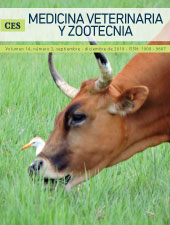Zootechnical parameters of Cavia porcellus in production systems in Nariño and Putumayo (Colombia)
DOI:
https://doi.org/10.21615/cesmvz.14.3.3Abstract
The guinea pig (Cavia porcellus) is a species of social and cultural importance in the southwestern region of Colombia. However, information on zootechnical variables is under development. The objective of this work was to identify the behavior of lines, productive and reproductive variables of guinea pigs in Nariño and Putumayo. A survey was applied in 404 productive systems of the municipalities of Pasto-Nariño and Colón, San Francisco, Santiago and Sibundoy-Putumayo. The data were processed in the program IBM-SPSS-Statistics® V. 20.0-2011. The distribution of lines corresponded to crosses: Criolla-Peru-Andina 61.4%, Criolla-14.8%, unidentified line 13.4%, Peru 9.65% and Andina 0.74%. The age at first mating (months) was lower for the Peruvian (5.1) and Andean (4.5) lines than in Creole animals (5.3). The number of births/ females/years in the Peruvian and Andean lines was 3.7 in Creole females was 3.4. The 97.3% of the producers have established groups of mount where the relation male: females, by lines was of 1:6, 1:8 and 1:4 for Criolla, Peru and Andina respectively. The average weights (g) at birth, weaning and benefit were: 222, 413 and 1330 (Criolla), 197, 390 and 1259 (Peru) and 125, 450 and 1300 (Andina) respectively. The age at weaning (days) was 24.5 (Criollos), 19.3 (Peru) and 18.3 days (Andina). It was evidenced predominance in the use of Creole lines and/or crosses. The Peruvian and Andean lines reported greater reproductive efficiency, the Creole race presented a greater productive efficiency. Due to the potential of the system, it is pertinent to carry out a broader characterization.
Downloads
References
Adan, A., Archer, S. N., Hidalgo,M. P., DiMilia, L., Natale, V., & Randler, C. (2012). Circadian typology: A comprehensive review. Chronobiology International, 29(9), 1153–1175. http://doi:10.3109/07420528.2012.719971.
Araújo, D. F. & Almondes, K. M. (2012). Qualidade de Sono e sua Relação com o Rendimento Acadêmico em Estudantes Universitários de Turnos Distintos. PSICO, Porto Alegre, 43(3), 350-359. http://revistaseletronicas.pucrs.br/ojs/index.php/revistapsico/article/viewArticle/9369
Au, J. & Reece, J. (2017). The relationship between chronotype and depressive symptoms: A metaanalysis. Journal of Affective Disorders. 218(2017), 93–104. http://dx.doi.org/10.1016/j.jad.2017.04.021
Beşoluk, Ş., Önder, I., & Deveci, I. (2011). Morningness–eveningness preference and academic achievement of university students. Chronobiology International, 28(2), 118–125. http://doi:10.3109/07420528.2010.540729.
Borbély, A.A. (1982) A two process model of sleep regulation. Human Neurobiology, 1(3), 195-204.
Curcio, G., Ferrara, M. & De Gennaro, L. (2006). Sleep loss, learning capacity and academic performance. Sleep Medicine Reviews, 10(5), 323-337. http://DOI:10.1016/j.smrv.2005.11.001
Díaz-Morales, J. F. (2015). Morningness–Eveningness Scale for Children (MESC): Spanish normative data and factorial invariance according to sex and age. Personality and Individual Differences, 87, 116–120. http://DOI:10.1016/j.paid.2015.07.027
Díaz-Morales, J. F., & Escribano, C. (2014). Consequences of adolescent‟s evening preference on psychological functioning: a review. Anales de Psicología, 30(3), 1096-1104. http://dx.doi.org/10.6018/analesps.30.3.167941
Díaz-Morales, J. F., & Escribano, C. (2015). Social jetlag, academic achievement and cognitive performance: Understanding sex/gender differences. Chronobiology International, 32(6), 822–831. http://doi:10.3109/07420528.2015.1041599.
Edel, R. (2003). El rendimiento académico: Concepto, Investigación y Desarrollo. Revista Electrónica Iberoamericana sobre Calidad, Eficacia y Cambio en Educación, 1(2), 1-15.
Enright, T. & Refinetti, R. (2017). Chronotype, class times, and academic achievement of university students. Chronobiol Int. 34(4), 445-450. http://doi:10.1080/07420528.2017.1281287
Escribano, C., Díaz-Morales, J. F., Delgado, P., & Collado, M. J. (2012). Morningness–eveningness and school performance among Spanish adolescents: Further evidence. Learning and Individual Differences, 22, 409–413. http://doi:10.1016/j.lindif.2011.12.008
Escribano, C. & Díaz-Morales, J.F. (2013). Rendimiento académico en adolescentes matutinos y vespertinos. Revista Iberoamericana de Diagnóstico y Evaluación, 36, 147-163.
Escribano, C. & Díaz-Morales, J.F. (2014). Daily fluctuations at school considering starting time and chronotype: An exploratory study. Chronobiology International, 31, 761–769. https://doi:10.3109/07420528.2014.898649
Escribano, C. & Díaz-Morales, J.F. (2016). Are achievement goals different among morning and evening-type adolescents?. Personality and Individual Differences, 88, 57–61. https://doi.org/10.1016/j.paid.2015.08.032
Horzum, M. B., Önder, I., & Beşoluk, Ş. (2014). Chronotype and academic achievement namong online learning students. Learning and Individual Differences, 30, 106–111. https://doi.org/10.1016/j.lindif.2013.10.017
Kanazawa, S., & Perina, K. (2009). Why night owls are more intelligent. Personality and Individual Differences, 47, 685–690. https://DOI:10.1016/j.paid.2009.05.021
Kolomeichuk, S., Randler, C., Shabalina, I., Fradkova, L. & Borisenkov, M. (2016). The influence of chronotype on the academic achievement of children and adolescents – evidence from Russian Karelia. Biological Rhythm Research, 47(6), 873-883. http://dx.doi.org/10.1080/09291016.2016.1207352
Machado-Duque, M.E., Echeverri-Chabur, J.E. & Machado-Alba, J.E. (2015). Somnolencia diurna excesiva, mala calidad del sueño y bajo rendimiento académico en estudiantes de Medicina. Rev Colomb Psiquiat, 44(3), 137–142. http://dx.doi.org/10.1016/j.rcp.2015.04.002
Medeiros, A., Mendes, D., Lima, P. & Araujo, J.F. (2001). The Relationships between Sleep-Wake Cycle and Academic Performance in Medical Students. Biological Rhythm Research. 32(2), 263-270. http://dx.doi.org/10.1076/brhm.32.2.263.1359
Merdad, R.A., Akil, H. & Wali, S.O. (2017). Sleepiness in Adolescents. Sleep Med Clin, 12(2017), 415–428. http://dx.doi.org/10.1016/j.jsmc.2017.03.014
Ministerio de Salud. (1993). Resolución 008430 por la cual se establecen las normas científicas, técnicas y administrativas para la investigación en salud. Santa Fe de Bogotá.
Preckel, F., Holling, H., & Vock, M. (2006). Academic underachievement: Relationship with cognitive motivation, achievement motivation, and conscientiousness. Psychology in the Schools, 43, 401–411. http://DOI:10.1002/pits.20154
Randler, C., & Frech, D. (2009). Young people's time-of-day preferences affect their school performance. Journal of Youth Studies, 12, 653–667. http://dx.doi.org/10.1080/13676260902902697
Randler, C., Freyth-Weber, K., Rahafar, A., Florez, A., & Kriegs, J. (2016). Morningness-eveningness in a large sample of German adolescents and adults. Heliyon, 2(2016), on line e00200. http://dx.doi.org/10.1016/j.heliyon.2016.e00200
Seo, D.& So, WY. (2014). Sleep duration and school performance in Korean adolescents. Salud Mental, 37, 407-413
Tonetti, L., Natale, V., & Randler, C. (2015a). Association between circadian preference and academic achievement: A systematic review and meta-analysis. Chronobiology International, 32, 792–801. http://doi:10.3109/07420528.2015.1049271
Tonetti, L., Adan, A., Di Milia, L., Randler, C., & Natale, V. (2015). Measures of circadian preference in childhood and adolescence: A review. European Psychiatry, 30, 576–582. http://doi:10.1016/j.eurpsy.2015.01.006
Van der Vinne, V., Zerbini, G., Siersema, A., Pieper, A., Merrow, M., Hut, R.A., … & Kantermann, T.(2014). J Biol Rhythms. (1), 53-60. http://doi:10.1177/0748730414564786
Vollmer, C., Pötsch, F., & Randler, C. (2013). Morningness is associated with better gradings and higher attention in class. Learning and Individual Differences, 27, 167–173. http://DOI:10.1016/j.lindif.2013.09.001
Downloads
Published
How to Cite
Issue
Section
License
Copyright (c) 2019 CES Medicina Veterinaria y Zootecnia

This work is licensed under a Creative Commons Attribution-NonCommercial-ShareAlike 4.0 International License.
| Article metrics | |
|---|---|
| Abstract views | |
| Galley vies | |
| PDF Views | |
| HTML views | |
| Other views | |



